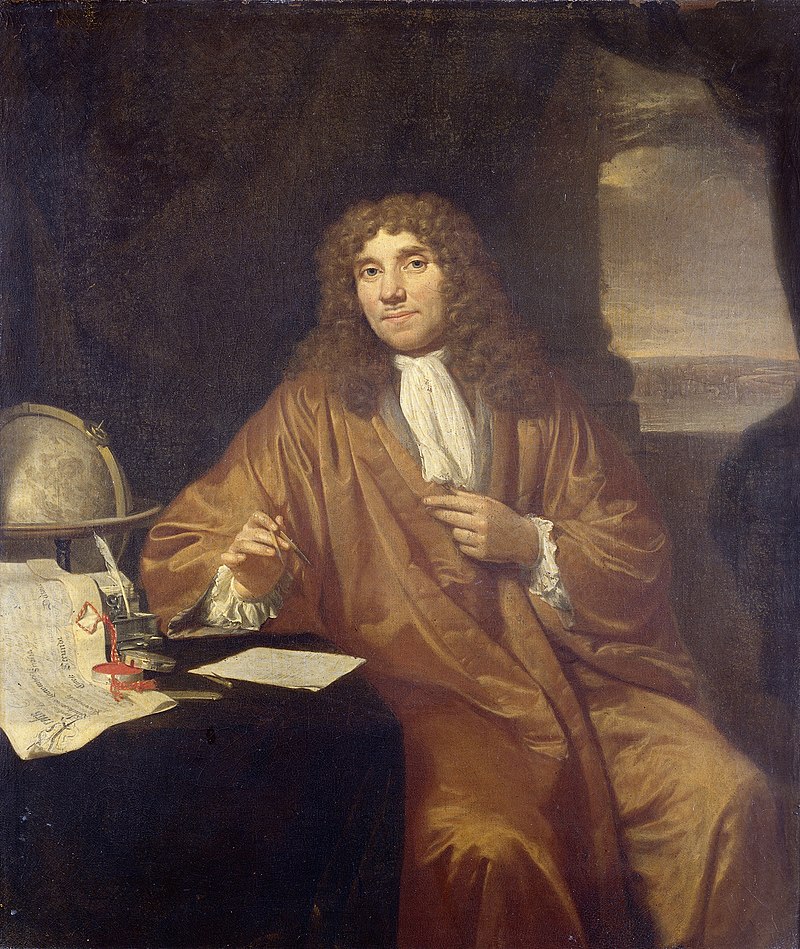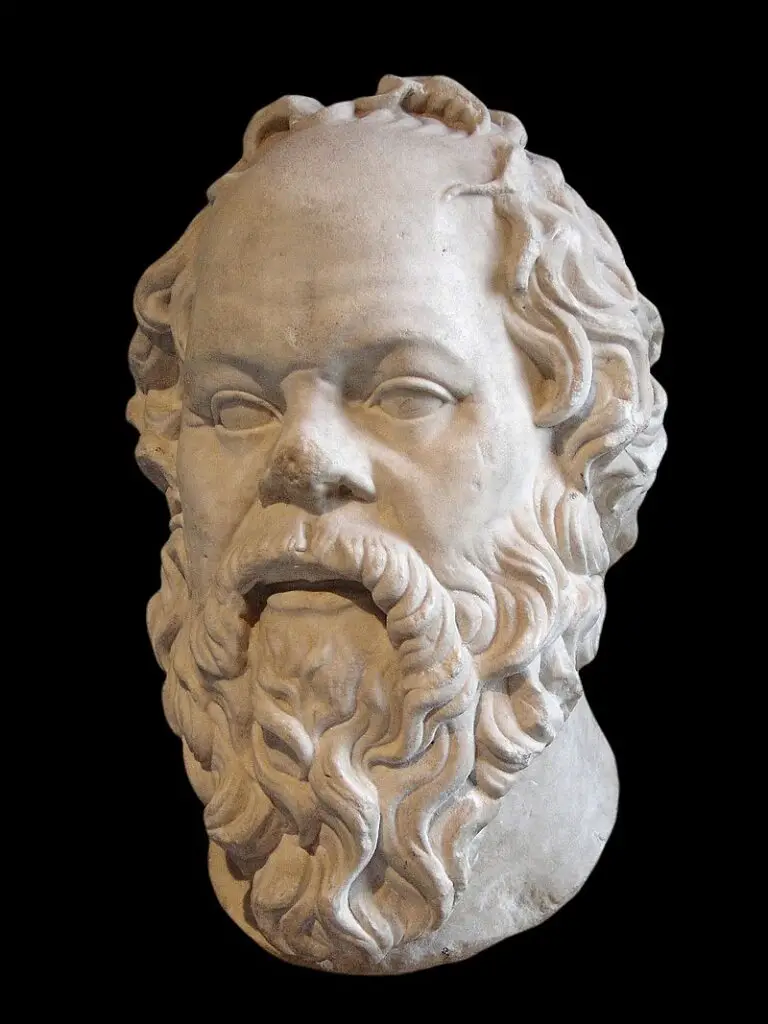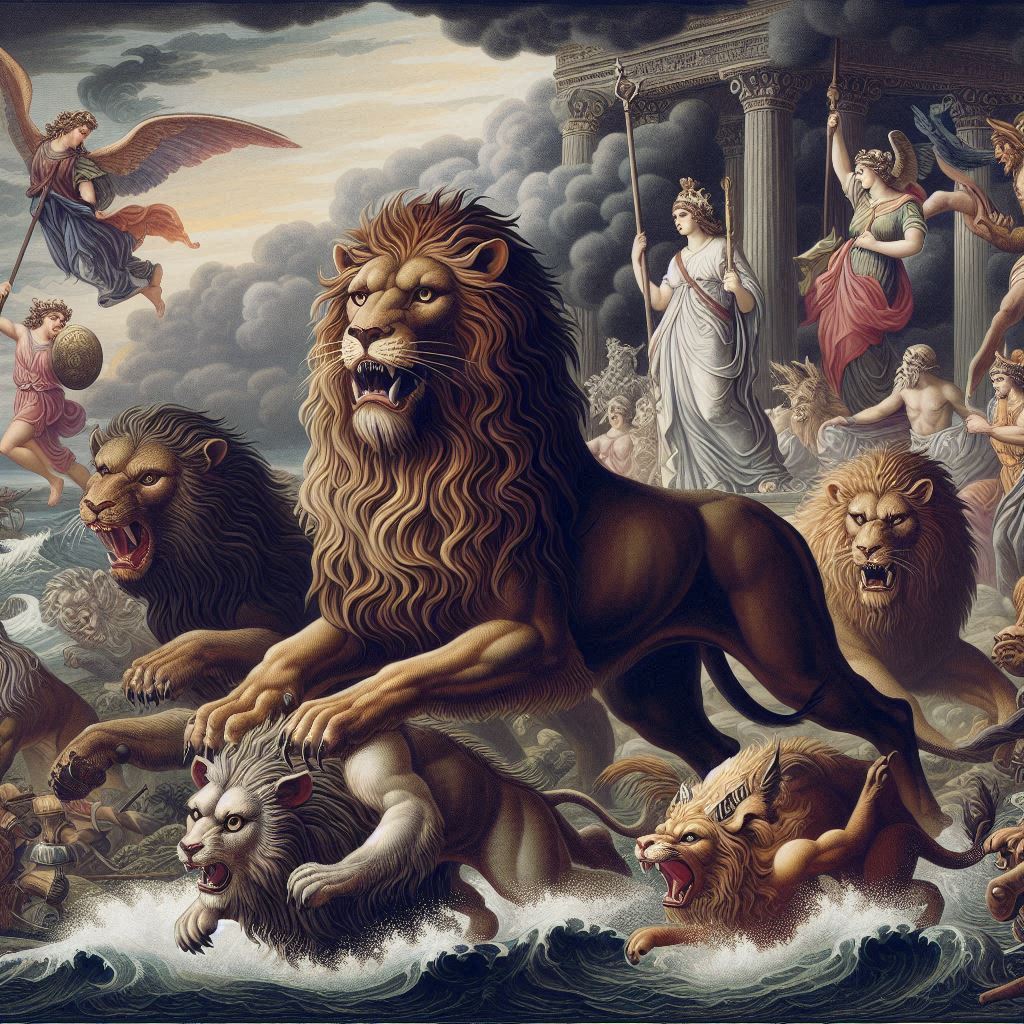Antonie van Leeuwenhoek (1632–1723) was a Dutch scientist and microscopist known for pioneering the field of microscopy. Using self-designed, single-lens microscopes, he made groundbreaking observations of microorganisms, including bacteria and protozoa. Leeuwenhoek’s meticulous observations laid the foundation for the understanding of the microscopic world, contributing significantly to the development of microbiology.
Early Life and Background
Antonie van Leeuwenhoek’s early life unfolded against the backdrop of 17th-century Delft, Netherlands. Born on October 24, 1632, to Margaretha Bel van den Berch and Philips Thooniszoon, Leeuwenhoek entered a world marked by socio-economic challenges and the turbulence of the Thirty Years’ War.
The Leeuwenhoek family was not affluent, and Antonie’s father, a basket maker, passed away when the young Antonie was just five years old. This early loss had a profound impact on the family’s financial stability, and Antonie’s mother struggled to make ends meet. Despite these challenges, young Antonie displayed an inquisitive mind and an innate curiosity about the natural world.
At the age of 16, following his father’s death, Antonie van Leeuwenhoek was apprenticed to a textile merchant. This marked the beginning of his involvement in the textile industry, a field that would shape his professional life. The textile industry was a vital aspect of Delft’s economy during that period, and Leeuwenhoek’s early experiences in the trade laid the foundation for his later career.
While the textile industry provided him with practical skills, Leeuwenhoek’s true passion lay in understanding the world beyond the threads and fibers. His insatiable thirst for knowledge led him to pursue learning independently, acquiring a wealth of information through extensive reading and self-education. Although he lacked formal scientific training, Leeuwenhoek’s intellectual curiosity and determination became driving forces propelling him toward a unique and groundbreaking path.
In 1654, at the age of 22, Leeuwenhoek married Barbara de Mey, and the couple eventually had five children. His marriage, along with the demands of his work in the textile trade, occupied much of his time during these early years. However, Leeuwenhoek’s curiosity about the natural world continued to burn brightly, and his spare moments were dedicated to exploration and experimentation.
Leeuwenhoek’s involvement in the cloth trade proved to be fortuitous for his scientific pursuits. The textile industry required precision, and Leeuwenhoek’s meticulous attention to detail, a skill honed through his trade, would later play a crucial role in the craftsmanship of his microscopes. Little did he know that his work with textiles would inadvertently prepare him for his groundbreaking contributions to microscopy.
It was around 1668 that Leeuwenhoek’s life took a transformative turn. His interest in lenses and optics led him to develop a keen fascination with microscopes. In an era when microscopes were still in their infancy, Leeuwenhoek decided to venture into lens-making, a decision that would set him on a trajectory toward scientific greatness.
Leeuwenhoek’s craftsmanship in lens-making was unparalleled. Through trial and error, he perfected the art of creating high-quality lenses, pushing the limits of magnification achievable at the time. His microscopes were simple yet effective, consisting of a single, powerful lens that could magnify objects several hundred times. This mastery of lens-making became the cornerstone of Leeuwenhoek’s scientific endeavors, enabling him to peer into a world previously unseen.
With his finely crafted microscopes in hand, Leeuwenhoek began his explorations into the microscopic realm. His first major discoveries were the microscopic organisms he termed “animalcules.” In a letter to the Royal Society dated 1676, Leeuwenhoek described these tiny creatures, meticulously documenting their movements and structures. This revelation marked a turning point in the history of biology and laid the foundation for the field of microbiology.
One of the remarkable aspects of Leeuwenhoek’s contributions is that he made these groundbreaking discoveries without the benefits of formal scientific education or collaboration with a scientific community. In fact, his lack of formal training became a point of contention among some contemporaries, who were skeptical of his achievements. However, Leeuwenhoek’s meticulous observations and the reproducibility of his findings using his microscopes gradually earned him the respect and recognition he deserved.
Leeuwenhoek’s observations weren’t limited to microbiology. He made significant contributions to anatomy, particularly in the study of muscle fibers and blood circulation. In a letter to the Royal Society in 1674, he provided detailed insights into the structure of red blood cells, contributing valuable information to the understanding of the circulatory system.
Despite his scientific achievements, Leeuwenhoek remained deeply connected to his work in the textile industry throughout his life. His dual roles as a tradesman and a pioneering scientist reflected the interdisciplinary nature of his pursuits. His ability to seamlessly navigate both worlds showcased the synergy between craftsmanship and scientific inquiry.
In 1680, Leeuwenhoek’s contributions to science were officially recognized when he was elected a fellow of the Royal Society of London. This prestigious acknowledgment signaled the acceptance of his work within the scientific community, validating his status as a pioneering figure in the burgeoning field of microscopy.
Antonie van Leeuwenhoek’s early life, marked by familial challenges and economic hardships, laid the foundation for his unconventional journey into the world of science. His self-directed education, coupled with his experiences in the textile trade, equipped him with the skills and mindset needed to make unprecedented contributions to microscopy and microbiology. The legacy of this self-taught scientist continues to inspire generations of researchers and underscores the transformative power of curiosity, determination, and hands-on exploration.
Microscopic Discoveries
Antonie van Leeuwenhoek’s microscopic discoveries revolutionized our understanding of the unseen world, elevating him to the status of the “Father of Microbiology.” Armed with his meticulously crafted microscopes, Leeuwenhoek made a series of groundbreaking observations that opened new frontiers in the exploration of the microscopic realm.
One of Leeuwenhoek’s earliest and most significant discoveries was the existence of microorganisms, which he referred to as “animalcules.” In a letter to the Royal Society in 1676, he described these minute creatures with remarkable detail. His observations extended to various environments, from rainwater to dental plaque, revealing a rich diversity of microscopic life. Leeuwenhoek’s descriptions were not confined to the mere presence of these organisms; he meticulously documented their movements, shapes, and sizes, providing a comprehensive account of a world previously invisible to the human eye.
Leeuwenhoek’s microscopes, with their unparalleled magnification capabilities, played a pivotal role in these discoveries. Unlike contemporary microscopes, which were often cumbersome and complex, Leeuwenhoek’s instruments were simple yet highly effective. His microscopes featured a single lens, meticulously ground to achieve exceptional clarity and magnification. This innovative design allowed him to achieve magnifications of up to 300 times, a feat that surpassed the capabilities of many of his contemporaries.
The precision of Leeuwenhoek’s lenses was a testament to his skills as a craftsman. His background in the textile industry, where attention to detail was paramount, uniquely positioned him to create lenses of extraordinary quality. This craftsmanship, combined with his relentless pursuit of perfection, enabled him to produce microscopes that surpassed the limitations of the time.
One of Leeuwenhoek’s famous observations was of bacteria. In his letters to the Royal Society, he described “globules” found in dental plaque, providing an early account of bacteria. His meticulous documentation included drawings of these microorganisms, revealing their diverse shapes and arrangements. Leeuwenhoek’s work paved the way for the understanding of bacteria as fundamental components of the natural world, setting the stage for later developments in microbiology.
Leeuwenhoek’s observations weren’t limited to bacteria; he also explored other microscopic wonders. In his letter dated September 17, 1683, he documented the existence of yeast cells, laying the groundwork for our understanding of fermentation. Leeuwenhoek’s meticulous recording of his observations, often accompanied by detailed drawings, showcased the rigor of his scientific approach.
One of the most remarkable aspects of Leeuwenhoek’s work was his ability to make sense of the unseen through empirical observation. At a time when the scientific method was still evolving, Leeuwenhoek’s emphasis on direct observation and accurate recording of his findings set him apart. His approach resonates with the essence of scientific inquiry—rigorous, evidence-based exploration of the natural world.
Leeuwenhoek’s microscopic studies extended beyond living organisms. In a letter dated October 9, 1676, he described the crystalline structure of minerals, marking an early foray into the microscopic examination of inorganic matter. His ability to apply his microscopic techniques to diverse subjects showcased the versatility of his instruments and their potential for uncovering the hidden intricacies of the world.
The impact of Leeuwenhoek’s discoveries reached far beyond the scientific community of his time. His letters, written in Dutch and often translated into Latin for wider dissemination, captured the attention of intellectuals across Europe. Scientists and scholars marveled at the detailed revelations about the microscopic world, and Leeuwenhoek’s work sparked a renewed interest in microscopy.
While Leeuwenhoek’s discoveries were met with fascination, they also faced skepticism. Some contemporaries questioned the authenticity of his observations, partly due to the secrecy surrounding the construction of his microscopes and his lack of formal scientific training. However, as other scientists, including members of the Royal Society, replicated his experiments and confirmed his findings, the skepticism gradually gave way to admiration.
Beyond microorganisms, Leeuwenhoek delved into the study of blood cells. In a letter to the Royal Society dated August 17, 1683, he provided a detailed account of his observations of red blood cells, describing their size and motion. His work contributed valuable insights to the understanding of the circulatory system, foreshadowing later developments in the field of physiology.
Leeuwenhoek’s microscopic investigations were not limited to his professional pursuits; they often extended into his personal life. In a letter dated September 7, 1688, he shared his observations of his own sperm, describing their rapid movement. This intimate exploration demonstrated Leeuwenhoek’s commitment to unraveling the mysteries of life at every level.
As a meticulous observer, Leeuwenhoek’s discoveries were not confined to a specific discipline. His microscopes allowed him to explore a diverse array of subjects, from the microscopic life in pond water to the fine structure of tissues. In doing so, he laid the groundwork for a holistic understanding of the microscopic world and its interconnectedness.
Antonie van Leeuwenhoek’s legacy is indelibly linked to his microscopic revelations. His pioneering work in microbiology, anatomy, and microscopy set the stage for future scientific advancements. The simplicity and precision of his microscopes, coupled with his unwavering commitment to empirical observation, continue to inspire scientists and researchers. Leeuwenhoek’s contributions not only expanded our understanding of the invisible world but also transformed the way we approach scientific inquiry, emphasizing the power of direct observation and meticulous documentation.
Scientific Contributions
Antonie van Leeuwenhoek’s microscopic discoveries revolutionized our understanding of the unseen world, elevating him to the status of the “Father of Microbiology.” Armed with his meticulously crafted microscopes, Leeuwenhoek made a series of groundbreaking observations that opened new frontiers in the exploration of the microscopic realm.
One of Leeuwenhoek’s earliest and most significant discoveries was the existence of microorganisms, which he referred to as “animalcules.” In a letter to the Royal Society in 1676, he described these minute creatures with remarkable detail. His observations extended to various environments, from rainwater to dental plaque, revealing a rich diversity of microscopic life. Leeuwenhoek’s descriptions were not confined to the mere presence of these organisms; he meticulously documented their movements, shapes, and sizes, providing a comprehensive account of a world previously invisible to the human eye.
Leeuwenhoek’s microscopes, with their unparalleled magnification capabilities, played a pivotal role in these discoveries. Unlike contemporary microscopes, which were often cumbersome and complex, Leeuwenhoek’s instruments were simple yet highly effective. His microscopes featured a single lens, meticulously ground to achieve exceptional clarity and magnification. This innovative design allowed him to achieve magnifications of up to 300 times, a feat that surpassed the capabilities of many of his contemporaries.
The precision of Leeuwenhoek’s lenses was a testament to his skills as a craftsman. His background in the textile industry, where attention to detail was paramount, uniquely positioned him to create lenses of extraordinary quality. This craftsmanship, combined with his relentless pursuit of perfection, enabled him to produce microscopes that surpassed the limitations of the time.
One of Leeuwenhoek’s famous observations was of bacteria. In his letters to the Royal Society, he described “globules” found in dental plaque, providing an early account of bacteria. His meticulous documentation included drawings of these microorganisms, revealing their diverse shapes and arrangements. Leeuwenhoek’s work paved the way for the understanding of bacteria as fundamental components of the natural world, setting the stage for later developments in microbiology.
Leeuwenhoek’s observations weren’t limited to bacteria; he also explored other microscopic wonders. In his letter dated September 17, 1683, he documented the existence of yeast cells, laying the groundwork for our understanding of fermentation. Leeuwenhoek’s meticulous recording of his observations, often accompanied by detailed drawings, showcased the rigor of his scientific approach.
One of the most remarkable aspects of Leeuwenhoek’s work was his ability to make sense of the unseen through empirical observation. At a time when the scientific method was still evolving, Leeuwenhoek’s emphasis on direct observation and accurate recording of his findings set him apart. His approach resonates with the essence of scientific inquiry—rigorous, evidence-based exploration of the natural world.
Leeuwenhoek’s microscopic studies extended beyond living organisms. In a letter dated October 9, 1676, he described the crystalline structure of minerals, marking an early foray into the microscopic examination of inorganic matter. His ability to apply his microscopic techniques to diverse subjects showcased the versatility of his instruments and their potential for uncovering the hidden intricacies of the world.
The impact of Leeuwenhoek’s discoveries reached far beyond the scientific community of his time. His letters, written in Dutch and often translated into Latin for wider dissemination, captured the attention of intellectuals across Europe. Scientists and scholars marveled at the detailed revelations about the microscopic world, and Leeuwenhoek’s work sparked a renewed interest in microscopy.
While Leeuwenhoek’s discoveries were met with fascination, they also faced skepticism. Some contemporaries questioned the authenticity of his observations, partly due to the secrecy surrounding the construction of his microscopes and his lack of formal scientific training. However, as other scientists, including members of the Royal Society, replicated his experiments and confirmed his findings, the skepticism gradually gave way to admiration.
Beyond microorganisms, Leeuwenhoek delved into the study of blood cells. In a letter to the Royal Society dated August 17, 1683, he provided a detailed account of his observations of red blood cells, describing their size and motion. His work contributed valuable insights to the understanding of the circulatory system, foreshadowing later developments in the field of physiology.
Leeuwenhoek’s microscopic investigations were not limited to his professional pursuits; they often extended into his personal life. In a letter dated September 7, 1688, he shared his observations of his own sperm, describing their rapid movement. This intimate exploration demonstrated Leeuwenhoek’s commitment to unraveling the mysteries of life at every level.
As a meticulous observer, Leeuwenhoek’s discoveries were not confined to a specific discipline. His microscopes allowed him to explore a diverse array of subjects, from the microscopic life in pond water to the fine structure of tissues. In doing so, he laid the groundwork for a holistic understanding of the microscopic world and its interconnectedness.
Antonie van Leeuwenhoek’s legacy is indelibly linked to his microscopic revelations. His pioneering work in microbiology, anatomy, and microscopy set the stage for future scientific advancements. The simplicity and precision of his microscopes, coupled with his unwavering commitment to empirical observation, continue to inspire scientists and researchers. Leeuwenhoek’s contributions not only expanded our understanding of the invisible world but also transformed the way we approach scientific inquiry, emphasizing the power of direct observation and meticulous documentation.
Correspondence with the Royal Society
Antonie van Leeuwenhoek’s correspondence with the Royal Society of London stands as a testament to his significant contributions to science and the microscopic world. Despite his lack of formal education, Leeuwenhoek’s letters, written in Dutch and later translated into Latin, became a bridge between his groundbreaking discoveries and the broader scientific community.
The first known communication between Leeuwenhoek and the Royal Society occurred in 1673 when he sent a letter detailing his observations of a bee’s stinger through a microscope. This initial letter, although brief, hinted at the precision and novelty of Leeuwenhoek’s microscopic techniques. The Royal Society, intrigued by his observations, requested further information and encouraged him to share more of his discoveries.
In subsequent letters, Leeuwenhoek expanded on his microscopic observations, introducing the Royal Society to a world teeming with previously unseen life. One of his early masterpieces, a letter dated September 17, 1674, detailed the discovery of “animalcules” in rainwater, forming the foundation of microbiology. Leeuwenhoek’s meticulous descriptions and drawings provided the Royal Society with a window into a microscopic universe that challenged existing scientific paradigms.
The Royal Society, recognizing the significance of Leeuwenhoek’s contributions, elected him a Fellow in 1680. This formal acknowledgment marked a turning point in his relationship with the scientific establishment, granting him the recognition he deserved despite his unconventional background. Leeuwenhoek’s status as a Fellow not only elevated his standing within the Royal Society but also legitimized his work within the wider scientific community.
Leeuwenhoek’s letters to the Royal Society continued to pour in, each unveiling new facets of the microscopic world. His correspondence covered an astonishing array of subjects, from his observations of blood cells to the detailed study of minerals. In a letter dated October 9, 1676, he delved into the crystalline structure of minerals, showcasing the versatility of his microscopic techniques.
One of Leeuwenhoek’s seminal contributions was his detailed study of bacteria, documented in a letter to the Royal Society dated May 1, 1676. He meticulously described the microbial life present in dental plaque, providing insights into the diversity and behavior of these tiny organisms. Leeuwenhoek’s work on bacteria not only expanded our understanding of microbiology but also laid the groundwork for future developments in the field.
The Royal Society, recognizing the significance of Leeuwenhoek’s discoveries, published many of his letters in its Philosophical Transactions. These publications served as a platform for disseminating his findings to a broader audience, ensuring that the scientific community at large could benefit from his groundbreaking observations. Leeuwenhoek’s letters became a source of inspiration for scientists across Europe, sparking a renewed interest in microscopy and the exploration of the unseen world.
Despite the acclaim his work received, Leeuwenhoek faced skepticism from some members of the Royal Society and the broader scientific community. His lack of formal education and the secrecy surrounding the construction of his microscopes fueled doubts about the authenticity of his observations. However, as other scientists, including prominent members of the Royal Society, replicated his experiments and confirmed his findings, the skepticism gradually gave way to acceptance.
Leeuwenhoek’s letters to the Royal Society weren’t limited to scientific observations; they also provided glimpses into his personal life. In a letter dated September 7, 1688, he shared his observations of his own sperm, showcasing his dedication to exploring the intricacies of life at every level. This personal touch, coupled with his scientific rigor, made his correspondence unique and captivating.
The Royal Society played a crucial role in facilitating Leeuwenhoek’s scientific journey. Its openness to unconventional ideas and commitment to the advancement of knowledge provided a supportive platform for his work. The society’s decision to publish his letters in its official journal amplified the impact of his discoveries, ensuring that they reached a wide audience of scholars, scientists, and intellectuals.
Leeuwenhoek’s relationship with the Royal Society endured until the end of his life. His final letter to the society, written in 1723, marked the conclusion of a remarkable scientific journey. In this farewell letter, Leeuwenhoek expressed gratitude for the honor bestowed upon him and reflected on the years of correspondence that had forged a unique bond between him and the Royal Society.
Antonie van Leeuwenhoek’s correspondence with the Royal Society remains a testament to the power of individual curiosity and the collaborative spirit of scientific inquiry. His letters not only expanded the boundaries of human knowledge but also exemplified the transformative potential of open-mindedness within the scientific community. Leeuwenhoek’s legacy, preserved in his letters and publications, continues to inspire scientists and researchers to explore the microscopic world with the same passion and dedication that fueled his groundbreaking discoveries.
Impact on Biology and Medicine
Antonie van Leeuwenhoek’s impact on biology and medicine is immeasurable, as his groundbreaking discoveries in the microscopic realm laid the foundation for major advancements in these fields. His meticulous observations of microorganisms and cells not only expanded our understanding of the natural world but also revolutionized the way scientists approached biology and medicine.
Leeuwenhoek’s microscopic studies had a profound influence on microbiology, a field that emerged from his pioneering observations of microorganisms. In a letter to the Royal Society dated September 17, 1683, he described the microscopic examination of tooth plaque, revealing a world teeming with bacteria. This marked the beginning of microbiology as a distinct scientific discipline.
His meticulous documentation of the diverse shapes and movements of these “animalcules” provided crucial insights into the microbial world. Leeuwenhoek’s work challenged prevailing notions about spontaneous generation and demonstrated that life existed at scales previously unimaginable. This revelation fundamentally altered our understanding of the living organisms that surround us and paved the way for the development of microbiological studies.
Leeuwenhoek’s contributions to microbiology were not limited to bacteria. In a letter dated May 1, 1676, he detailed his observations of protozoa, tiny single-celled organisms with complex structures and behaviors. These findings expanded the scope of microbiological research, showcasing the incredible diversity of microscopic life. Leeuwenhoek’s work in this area laid the groundwork for the classification and study of various microorganisms, contributing to the development of microbiological taxonomy.
The impact of Leeuwenhoek’s discoveries on medicine was equally profound. His meticulous examination of red blood cells, as detailed in a letter to the Royal Society dated August 17, 1683, provided crucial insights into the circulatory system. By describing the size and motion of red blood cells, Leeuwenhoek contributed valuable information to the understanding of blood physiology, laying the foundation for future developments in hematology.
Leeuwenhoek’s observations also extended to sperm cells, as seen in his letter dated September 7, 1688. His detailed study of his own sperm, including observations of their rapid movement, contributed to the early understanding of reproductive biology. While the significance of sperm had been recognized before, Leeuwenhoek’s microscopic observations added a new level of detail and precision to the understanding of sexual reproduction.
Furthermore, Leeuwenhoek’s work on yeast cells, as described in his letter dated September 17, 1683, had implications for the field of fermentation and, by extension, medicine. His observations provided early insights into the role of microorganisms in processes like brewing and baking, setting the stage for the later discoveries of Louis Pasteur and the germ theory of disease. The understanding that microorganisms played a role in fermentation and disease transmission had profound implications for public health and medical practices.
Beyond specific discoveries, Leeuwenhoek’s impact on biology and medicine can be traced to his pioneering use of the microscope. His microscopes, with their unprecedented magnification capabilities, opened a new frontier for scientific inquiry. The ability to observe and study microscopic structures fundamentally changed the way scientists approached biological phenomena. Leeuwenhoek’s emphasis on empirical observation and direct examination of specimens laid the groundwork for the scientific method in biology.
Leeuwenhoek’s influence extended beyond his immediate contemporaries. His letters, written in Dutch and later translated into Latin, were disseminated widely, capturing the attention of scientists, intellectuals, and physicians across Europe. The Royal Society’s publication of his letters in the Philosophical Transactions ensured that Leeuwenhoek’s discoveries reached a broad audience, sparking a renewed interest in microscopy and the study of the unseen world.
The transformative impact of Leeuwenhoek’s work on biology and medicine continued to unfold over the centuries. His observations inspired subsequent generations of scientists to explore the microscopic realm, leading to further advancements in microbiology, cell biology, and medical research. The development of more sophisticated microscopes and imaging techniques, building on the principles established by Leeuwenhoek, allowed for even deeper insights into the intricacies of life at the cellular and molecular levels.
Personal Characteristics
Antonie van Leeuwenhoek, known for his groundbreaking contributions to microscopy and microbiology, exhibited a range of personal characteristics that played a crucial role in shaping his scientific journey. From innate curiosity and determination to meticulous attention to detail, Leeuwenhoek’s qualities as an observer and experimenter set him apart as a pioneering figure in the history of science.
Curiosity was a defining trait in Leeuwenhoek’s character. From a young age, he displayed an inquisitive mind, seeking to understand the world around him. This curiosity was a driving force that led him to explore the intricacies of lenses and optics during his time as a draper. As he delved into the textile trade, his interest in lenses grew, eventually propelling him into the realm of microscopy. His insatiable curiosity about the microscopic world fueled his lifelong dedication to scientific inquiry.
A remarkable aspect of Leeuwenhoek’s character was his ability to combine practical skills with scientific pursuits. As a linen draper, he gained hands-on experience with lenses and developed a keen eye for precision, skills that would prove essential in the construction of his microscopes. This practical knowledge, coupled with his innate curiosity, allowed him to transform simple lenses into powerful instruments of discovery. Leeuwenhoek’s proficiency in lens grinding, a skill acquired in the textile trade, became a key element in the success of his microscopic observations.
Determination and perseverance were evident throughout Leeuwenhoek’s scientific career. Despite lacking formal scientific education and facing skepticism from contemporaries, he remained steadfast in his pursuit of understanding the microscopic world. His determination to overcome challenges and persist in his observations allowed him to make groundbreaking discoveries that would later earn him recognition from the scientific community.
Attention to detail was a hallmark of Leeuwenhoek’s character. His meticulous observations, often accompanied by precise measurements and detailed drawings, set a standard for scientific rigor. Whether describing the movements of microorganisms or documenting the structure of red blood cells, Leeuwenhoek’s attention to detail ensured the accuracy and reliability of his findings. This characteristic not only contributed to the credibility of his work but also laid the foundation for future scientific methodologies.
Secrecy and a sense of independence were also notable aspects of Leeuwenhoek’s character. He kept the details of his lens-grinding techniques closely guarded, creating an air of mystery around his microscopes. This secrecy, coupled with his ability to work independently, added to the uniqueness of his instruments. While some contemporaries may have viewed this secrecy with suspicion, it underscored Leeuwenhoek’s commitment to maintaining the quality and effectiveness of his microscopes.
Leeuwenhoek’s humility and lack of formal arrogance are noteworthy aspects of his character. Despite his remarkable achievements, he referred to himself as a “tradesman” and acknowledged his limited formal education. His humility was evident in his correspondence with the Royal Society, where he shared his observations and findings without seeking undue recognition. This lack of arrogance allowed his work to stand on its own merit, transcending societal expectations and biases.
A sense of civic duty was another facet of Leeuwenhoek’s character. Alongside his scientific pursuits, he actively participated in civic responsibilities in Delft. Serving as a chamberlain and later as a land surveyor, Leeuwenhoek demonstrated a commitment to contributing to the welfare of his local community. This dual role, as both a scientist and a civic-minded individual, showcased the breadth of his character and the balance he maintained between scientific exploration and societal engagement.
Leeuwenhoek’s communication skills were essential in conveying his discoveries to the scientific community. Despite facing skepticism initially, his letters to the Royal Society were written with clarity and precision. His ability to articulate complex observations in a comprehensible manner contributed to the acceptance of his work and fostered communication between scientists of his time.
The Mystery of Lens Grinding
The mystery surrounding Antonie van Leeuwenhoek’s lens-grinding techniques adds an intriguing dimension to his pioneering work in microscopy. While he left an indelible mark on the history of science with his groundbreaking observations of the microscopic world, the specifics of how he crafted his lenses remained a closely guarded secret. This mystery has fueled speculation and curiosity, contributing to the enigmatic aura surrounding Leeuwenhoek’s microscopes.
Leeuwenhoek’s lenses were a crucial component of his success in observing microorganisms at a level of detail previously unattainable. His microscopes, characterized by their small size and single-lens design, surpassed the capabilities of contemporary compound microscopes. The precision of his lenses allowed for magnifications of up to 300 times, enabling him to delve into the microscopic realm with unprecedented clarity.
The secrecy surrounding Leeuwenhoek’s lens-grinding techniques was not accidental but deliberate. In an era where knowledge was often shared openly among scientists, Leeuwenhoek chose to keep the details of his craft confidential. The reasons for this secrecy remain speculative, with some suggesting that he sought to protect his trade secrets, while others propose that he aimed to maintain a competitive advantage in lens quality.
Leeuwenhoek’s background as a linen draper likely played a significant role in his approach to lens grinding. The textile trade of the 17th century required a keen understanding of optics to assess the quality of fabrics. Leeuwenhoek, with his practical experience in this trade, may have acquired insights into lens grinding that were not readily available to his contemporaries.
The mystery deepens when considering the limitations of the technology and knowledge available in Leeuwenhoek’s time. The tools and techniques for crafting lenses were not as advanced as they are today, making his achievements even more remarkable. The absence of formal scientific education further emphasizes the unique nature of his contributions.
One aspect that has fueled speculation is the size of Leeuwenhoek’s lenses. His microscopes featured tiny, high-quality lenses, some measuring less than a millimeter in diameter. Crafting lenses of such minuscule dimensions with 17th-century technology posed a considerable challenge. The precision required to achieve these sizes suggests a level of skill and craftsmanship that went beyond the norm of the time.
The materials used in Leeuwenhoek’s lenses also contribute to the mystery. While the exact composition remains unknown, it is believed that he used carefully selected glass or crystal. The sourcing and treatment of these materials could have been crucial factors in achieving the optical quality required for his microscopes.
One plausible theory proposes that Leeuwenhoek’s lenses were not ground in the traditional sense but rather polished. This approach involves shaping the lens through abrasive polishing rather than grinding with a grinding wheel. Polishing allows for greater control over the lens shape and may have contributed to the precision and small size of Leeuwenhoek’s lenses.
The mystery of Leeuwenhoek’s lens grinding extends beyond the technical aspects to the philosophical. Some historians of science have pondered whether the secrecy surrounding his methods was intentional mystique or if Leeuwenhoek simply considered the lens-grinding process mundane and unworthy of detailed explanation. In an era where scientific communication was becoming more formalized, Leeuwenhoek’s approach stood out as an anomaly.
Despite the secrecy, Leeuwenhoek’s microscopes were highly sought after. Scientists and institutions coveted these instruments for the unparalleled magnification they offered. Leeuwenhoek’s microscopes were not mass-produced; each was a unique creation crafted by his hands. This scarcity further heightened the desirability and mystery surrounding his lenses.
The impact of Leeuwenhoek’s microscopes on the scientific community cannot be overstated. His observations of microorganisms opened new vistas in biology and microbiology, challenging existing paradigms and expanding the boundaries of human knowledge. The mystery of his lens-grinding techniques, while intriguing, has not diminished the significance of his contributions but has added an element of fascination to his legacy.
In the centuries that followed Leeuwenhoek, advancements in lens-making technology and microscopy have unveiled the secrets of the microscopic world in ever greater detail. Modern techniques have allowed scientists to peer into the nanoscale, surpassing the limitations of Leeuwenhoek’s time. However, the legacy of his mystery endures, serving as a reminder of the ingenuity and determination of a curious draper who unlocked the secrets of the unseen world with lenses shrouded in enigma.
Contemporaries and Critics
Antonie van Leeuwenhoek’s microscopic observations, while groundbreaking, were not universally embraced by his contemporaries. In the 17th century scientific community, where established theories often held sway, Leeuwenhoek’s findings challenged existing beliefs and were met with skepticism. As a result, he faced both admirers who recognized the significance of his work and critics who questioned the validity of his observations.
One notable contemporary who appreciated Leeuwenhoek’s contributions was Robert Hooke, an English scientist known for his own work in microscopy. Hooke, who had observed cells in cork using a compound microscope, was intrigued by Leeuwenhoek’s single-lens microscopes and the detailed observations he made. Hooke acknowledged the uniqueness of Leeuwenhoek’s instruments and the significance of his discoveries, although he did not fully endorse all aspects of his work.
The Royal Society, a prominent scientific institution in London, played a crucial role in Leeuwenhoek’s interactions with his contemporaries. In 1673, he communicated his observations to the Royal Society in a letter describing microorganisms in water. While some members, including Hooke, were intrigued, others were skeptical. The unfamiliar nature of Leeuwenhoek’s microorganisms and his lack of formal scientific training led to initial doubts about the validity of his findings.
Leeuwenhoek’s letters to the Royal Society continued over the years, providing a steady stream of microscopic observations. Some members, such as Henry Oldenburg, the secretary of the Royal Society, recognized the importance of Leeuwenhoek’s work and played a key role in disseminating his findings to the wider scientific community. Oldenburg, in particular, saw the potential impact of Leeuwenhoek’s microscopy on the advancement of scientific knowledge.
However, not all members of the Royal Society were immediately convinced. The unfamiliarity of Leeuwenhoek’s microorganisms and the lack of corroborating evidence from other scientists raised doubts among some scholars. The scientific community of the time operated in a climate where established authorities held significant influence, and challenging prevailing views required strong evidence and support.
Leeuwenhoek’s observations of microorganisms in seminal fluid, particularly his detailed descriptions of sperm cells, faced considerable skepticism. The idea of tiny beings existing in the reproductive fluids challenged prevailing notions of human reproduction. Some scientists were hesitant to accept these observations without further corroborating evidence, and debates ensued within the scientific community.
Critics of Leeuwenhoek’s work often questioned the reliability of his microscopes and the accuracy of his descriptions. The small size of his lenses, some measuring less than a millimeter in diameter, and the lack of information about his lens-grinding techniques contributed to suspicions about the validity of his observations. The secrecy surrounding his lenses, while enhancing their mystique, also fueled doubts among those who sought more transparency in scientific methodologies.
Leeuwenhoek’s lack of formal education in science was another point of contention among his critics. In an era where university degrees and scholarly credentials held significant weight, Leeuwenhoek’s background as a draper with no formal training in the sciences raised eyebrows. Some skeptics argued that his lack of education might have led him to misinterpret or exaggerate his observations.
Despite the skepticism and criticism, Leeuwenhoek’s meticulous observations and the clarity of his drawings began to win over some members of the scientific community. The Royal Society eventually elected him as a Fellow in 1680, recognizing the importance of his contributions to the field of microscopy. This acknowledgment marked a turning point in the reception of Leeuwenhoek’s work within the scientific establishment.
One of Leeuwenhoek’s notable critics was Johannes Swammerdam, a Dutch naturalist and entomologist. Swammerdam, known for his work on insect anatomy, expressed skepticism about Leeuwenhoek’s observations of insects and challenged some of his findings. The two engaged in a scientific dispute, exchanging letters in which they presented their arguments and counterarguments. This exchange highlighted the rigorous scrutiny that Leeuwenhoek’s work faced, even from fellow scientists.
While Leeuwenhoek had his share of critics, he also had admirers who recognized the significance of his contributions. His microscopes, characterized by their simplicity and effectiveness, inspired other scientists to explore the microscopic world. Leeuwenhoek’s ability to observe and document previously unseen phenomena paved the way for advancements in microscopy and microbiology.
In the context of his time, Leeuwenhoek’s work was a testament to the power of observation and empirical inquiry. His lack of formal education did not hinder his ability to make groundbreaking contributions to science. Instead, it showcased the potential for individuals outside the academic establishment to contribute meaningfully to the advancement of knowledge.
Final Years and Death
Antonie van Leeuwenhoek’s final years were marked by continued scientific exploration, recognition for his contributions, and the legacy of a man whose curiosity had reshaped our understanding of the microscopic world. As he entered the latter part of his life, Leeuwenhoek’s work continued to inspire awe and curiosity, leaving an indelible mark on the scientific community.
In the later years of the 17th century, Leeuwenhoek’s reputation as a microscopist had solidified. The Royal Society in London continued to receive his letters, each containing detailed observations of microorganisms and microscopic structures. Despite initial skepticism, his work had gained increasing acceptance among scientists who recognized the precision and rigor of his observations.
One of the remarkable aspects of Leeuwenhoek’s final years was the breadth of his observations. His letters covered a wide range of subjects, from detailed studies of various microorganisms to examinations of bodily fluids and tissues. Leeuwenhoek’s insatiable curiosity led him to explore the microscopic world with an open mind, and his ability to convey his findings with clarity and detail ensured the continued interest of the scientific community.
In 1680, Leeuwenhoek’s contributions were officially acknowledged when he was elected as a Fellow of the Royal Society. This recognition from one of the leading scientific institutions of the time reflected the growing acceptance of his work within the broader scientific community. It was a testament to his perseverance and the impact of his microscopic discoveries.
As he aged, Leeuwenhoek’s passion for scientific inquiry remained undiminished. His observations extended beyond microorganisms to include studies of muscle fibers, the crystalline lens of the eye, and even meteorological phenomena. His letters to the Royal Society became a regular conduit for sharing his findings, and he maintained an active correspondence with scientists across Europe.
Despite his scientific achievements, Leeuwenhoek continued to face challenges from those who questioned the validity of his work. The unfamiliarity of the microscopic realm and the precision of his observations led some to remain skeptical, and debates persisted within the scientific community. However, Leeuwenhoek’s meticulous documentation and the quality of his microscopes gradually silenced many of his critics.
In his final years, Leeuwenhoek’s health began to decline. The toll of years of intense scientific observation and the demands of his work as a tradesman likely took a physical toll. Yet, even in the face of health challenges, he continued his scientific pursuits with remarkable vigor.
Antonie van Leeuwenhoek passed away on August 26, 1723, in Delft, the city of his birth and scientific exploration. His death marked the end of a life dedicated to unraveling the mysteries of the unseen world. While he may not have witnessed the full extent of the impact his work would have on future generations, Leeuwenhoek’s legacy continued to unfold long after his passing.
The significance of Leeuwenhoek’s contributions became increasingly apparent in the centuries that followed. His microscopes, meticulously crafted and shrouded in mystery, became artifacts of scientific history. Museums and institutions preserved these instruments as a testament to the ingenuity of a man who, despite lacking formal scientific education, had reshaped the landscape of microscopy.
The impact of Leeuwenhoek’s work extended beyond the confines of his era. The discoveries he made laid the groundwork for advancements in microbiology and paved the way for subsequent generations of scientists to explore the unseen world. His influence is evident in the development of more sophisticated microscopes and the continued refinement of techniques for studying microscopic life.
The mystery surrounding Leeuwenhoek’s lens-grinding techniques endured, adding an element of fascination to his legacy. Scholars and historians have speculated about the methods he employed to create lenses of such precision with the technology available in the 17th century. The enigma surrounding his microscopes has become an integral part of the narrative surrounding Leeuwenhoek, contributing to the mystique that surrounds his contributions to science.
As the years passed, Antonie van Leeuwenhoek’s name became synonymous with the spirit of curiosity and the power of observation. His story serves as a testament to the idea that groundbreaking discoveries can emerge from unexpected quarters. His legacy endures not only in the annals of scientific history but also in the inspiration he provides to aspiring scientists and enthusiasts alike.
Legacy and Recognition
Antonie van Leeuwenhoek’s legacy is an enduring testament to the transformative power of curiosity, observation, and the pursuit of knowledge. His groundbreaking contributions to microscopy and microbiology not only reshaped scientific understanding in his time but also laid the foundation for future advancements in these fields. Leeuwenhoek’s legacy extends beyond his immediate contributions, influencing the trajectory of scientific exploration and inspiring generations of researchers.
One of the most significant aspects of Leeuwenhoek’s legacy is his role in advancing the field of microscopy. His development of single-lens microscopes with unprecedented magnification capabilities opened a new frontier in scientific observation. By meticulously grinding and crafting lenses of unparalleled quality, he unlocked the ability to explore the microscopic world with clarity and precision. This innovation revolutionized the study of living organisms at the cellular and microbial levels.
Leeuwenhoek’s microscopes were not only instruments of scientific inquiry but also symbols of craftsmanship. The mystery surrounding his lens-grinding techniques added an element of fascination to his work. The meticulous construction of his microscopes showcased the importance of precision in scientific instrumentation, setting a standard for the quality of lenses that would become foundational in microscopy.
The impact of Leeuwenhoek’s microscopic observations on the field of microbiology is immeasurable. His detailed studies of microorganisms, which he termed “animalcules,” laid the groundwork for understanding the diversity and complexity of the microbial world. His descriptions and illustrations of bacteria, protozoa, and other microscopic entities provided a firsthand glimpse into a realm previously unseen by human eyes.
Leeuwenhoek’s legacy is particularly evident in his detailed observations of bacteria. His discovery of bacteria in dental plaque and other substances challenged prevailing notions about the nature of these microscopic beings. In an era when the existence of microorganisms was not widely accepted, Leeuwenhoek’s work paved the way for the germ theory of disease and the understanding of the role of microorganisms in various biological processes.
The impact of Leeuwenhoek’s discoveries on the scientific community was not immediate. Initially met with skepticism, his meticulous observations eventually garnered recognition and acceptance. The Royal Society’s election of Leeuwenhoek as a Fellow in 1680 acknowledged the importance of his contributions and marked a significant moment in the validation of his work by the scientific establishment.
Leeuwenhoek’s legacy also extends to the realm of scientific communication. His letters to the Royal Society, filled with detailed observations, precise measurements, and accurate drawings, exemplify effective scientific communication. Despite lacking formal education in science, Leeuwenhoek’s ability to convey his findings with clarity and rigor contributed to the acceptance of his work within the scientific community.
Beyond his immediate scientific contributions, Leeuwenhoek’s legacy includes the inspiration he provided to subsequent generations of scientists. His story serves as a reminder that scientific inquiry is not confined to traditional academic settings or formal education. Leeuwenhoek’s background as a draper and his lack of formal scientific training did not hinder his ability to make groundbreaking discoveries. His life exemplifies the idea that curiosity, perseverance, and a commitment to empirical observation can lead to transformative contributions to scientific knowledge.
In the broader context of scientific history, Leeuwenhoek’s legacy is intertwined with the evolution of microscopy. The development of more sophisticated microscopes over the centuries has allowed scientists to delve even deeper into the microscopic realm. From the advent of compound microscopes to the modern era of electron microscopy, each advancement builds upon the foundations laid by Leeuwenhoek’s pioneering work.
The mystery surrounding Leeuwenhoek’s lens-grinding techniques has become a captivating part of his legacy. Speculations and theories about the methods he employed to create lenses with such precision have added an element of intrigue to his story. While the specifics remain unknown, the mystery highlights the ingenuity and craftsmanship associated with Leeuwenhoek’s microscopes.
Recognition of Leeuwenhoek’s contributions has extended into various facets of society. His legacy is celebrated not only within the scientific community but also in museums and educational institutions worldwide. Exhibits dedicated to his life and work showcase his microscopes, letters, and drawings, allowing the public to engage with the story of a curious draper who unraveled the mysteries of the microscopic world.
In his hometown of Delft, the Antoni van Leeuwenhoek House stands as a tribute to his life and legacy. Preserving the atmosphere of his time, the house provides visitors with a glimpse into Leeuwenhoek’s world and the environment in which he conducted his groundbreaking observations. The house stands as a testament to the enduring impact of Leeuwenhoek’s contributions.
The naming of the genus Leeuwenhoekiella, a group of bacteria, in honor of Antonie van Leeuwenhoek reflects the lasting influence of his work in the field of microbiology. This taxonomic recognition underscores the significance of his pioneering observations, which continue to shape our understanding of microbial diversity and ecology.










